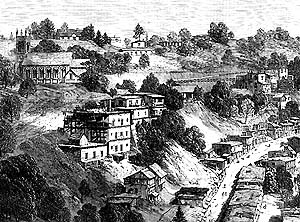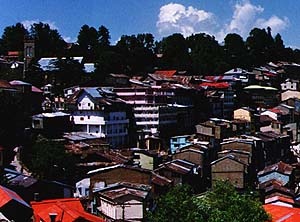 |
 |
 |
 |
The Illustrated London News
November 20, 1869
| Murree has expanded since 1947 much faster than its infrastructure can sustain. Securing its water and electricity supplies is a constant challenge. The packed bazaar has burned down a number of times in the last century. The growth of tourism and a construction boom have left bare hills in their wake. |
| Another road with shops has been built between the two major roads beneath the Mall visible in the 1863 view. The Church is still there, as is the white building across the Mall then just being constructed. Many of the houses above and behind the Church are still standing, often as hotels in various states of repair. |
| The major problem - cholera - described in the 1893-94 Gazeteer is, however, absent today: |
| "The site of the station was selected in 1850, and in 1851 troops were first quartered there [Observatory Hill, from where the above views were made]. The permanent barracks were erected in 1853. During the Mutiny [the War of Independence in1857-58], the Dhunds, a tribe inhabiting the neighbouring hills, incited by the Hindustanis of the station, made an attack upon Murree, but timely notice of their intentions having been given, their ill-armed levies were easily dispersed. In 1858, and again in 1867, there were epidemics of cholera; and mortality was very great, another outbreak occurred in 1888. Of late years also there have been occasional visitations of the disease, generally importations from the plains. Up till 1876, Murree was the summer headquarters of the [Punjab] Local Government, which has now forsaken it for Simla." |
| The Illustrated London News published this woodprint in a series from Captain Robert T. Hickey's trip through the area in 1863. His photographs served as the basis of a number of other wood engravings published that year. They show how quickly the albumen photograph, invented in England in 1851, was absorbed by the print media. By 1857, photographs from India were often used by weeklies to make wood engravings. |
| The accompanying description in the Illustrated London News: "The Engraving on page 512 is a view of the hill-station of Murree, which was established, in 1851, as a place of sanitary abode for the Europeans, both in the civil and military services, appointed to do duty in the sultry plains of the Punjaub. Murree, situated in north latitude 33 deg. 54 min., and in the east longitude 27 deg. 27 min., stands upon a hill at the confluence of the two rivers Indus and Jhelum; and its elevated position, 7330 ft. above the sea-level, allows it to enjoy a temperate climate. |
| "Most of the common fruits of Britain, including cherries, raspberries, and strawberries, are there produced in season. The extensive barracks at Murree, for troops removed thither to restore their health, and the number of villas and other houses erected for the accomodation of English families, give it a quite European aspect. The railway communication with Lahore, the capital of the Punjaub, makes this a place of frequent resort of the wearied officials, employed in the government and judicial administration of that great province of our Indian empire." |